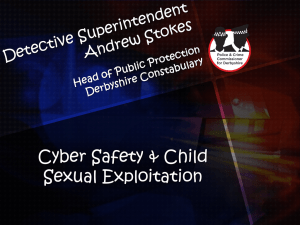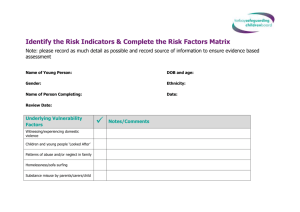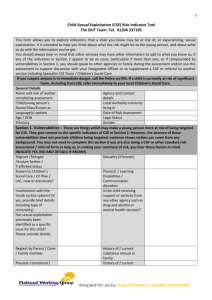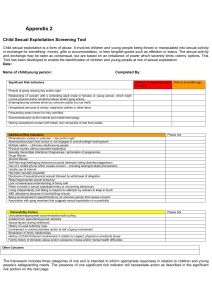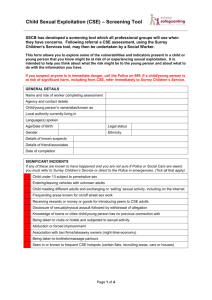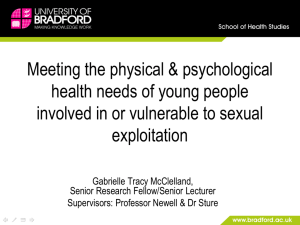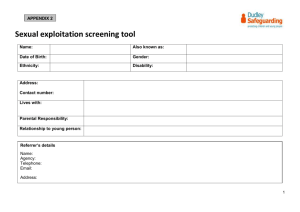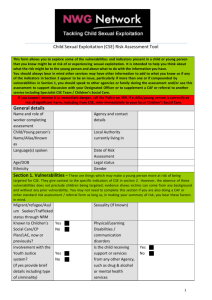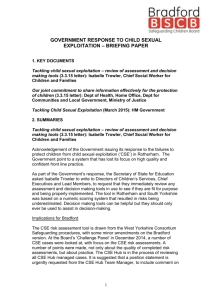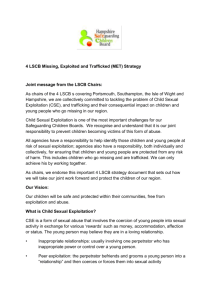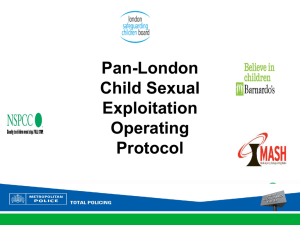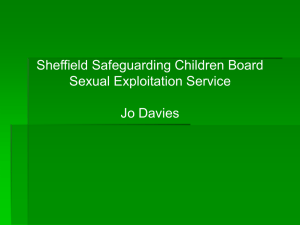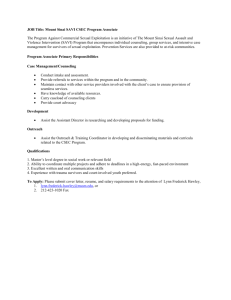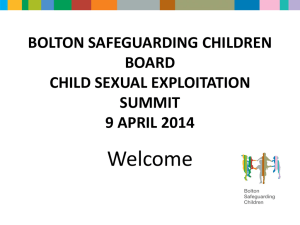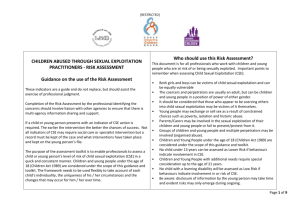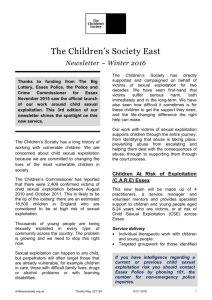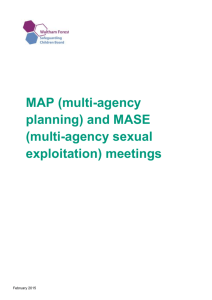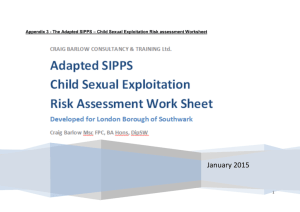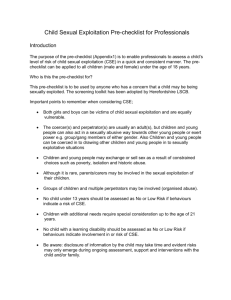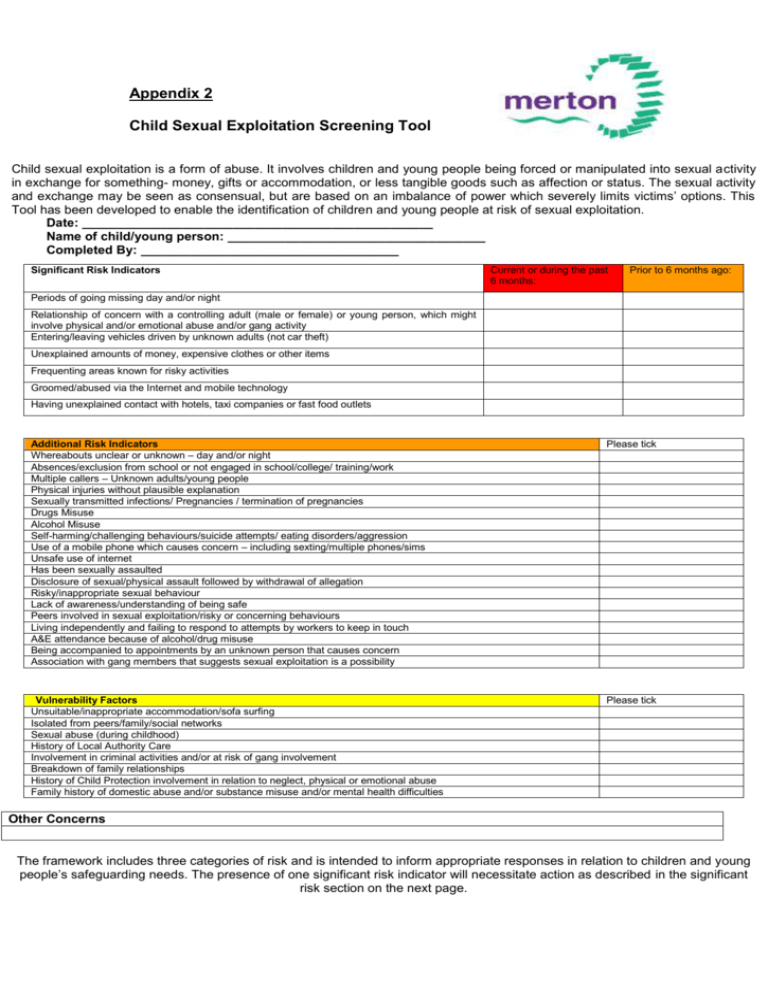
Appendix 2
Child Sexual Exploitation Screening Tool
Child sexual exploitation is a form of abuse. It involves children and young people being forced or manipulated into sexual activity
in exchange for something- money, gifts or accommodation, or less tangible goods such as affection or status. The sexual activity
and exchange may be seen as consensual, but are based on an imbalance of power which severely limits victims’ options. This
Tool has been developed to enable the identification of children and young people at risk of sexual exploitation.
Date: _________________________________________________
Name of child/young person: ____________________________________
Completed By: ____________________________________
Significant Risk Indicators
Current or during the past
6 months:
Prior to 6 months ago:
Periods of going missing day and/or night
Relationship of concern with a controlling adult (male or female) or young person, which might
involve physical and/or emotional abuse and/or gang activity
Entering/leaving vehicles driven by unknown adults (not car theft)
Unexplained amounts of money, expensive clothes or other items
Frequenting areas known for risky activities
Groomed/abused via the Internet and mobile technology
Having unexplained contact with hotels, taxi companies or fast food outlets
Additional Risk Indicators
Whereabouts unclear or unknown – day and/or night
Absences/exclusion from school or not engaged in school/college/ training/work
Multiple callers – Unknown adults/young people
Physical injuries without plausible explanation
Sexually transmitted infections/ Pregnancies / termination of pregnancies
Drugs Misuse
Alcohol Misuse
Self-harming/challenging behaviours/suicide attempts/ eating disorders/aggression
Use of a mobile phone which causes concern – including sexting/multiple phones/sims
Unsafe use of internet
Has been sexually assaulted
Disclosure of sexual/physical assault followed by withdrawal of allegation
Risky/inappropriate sexual behaviour
Lack of awareness/understanding of being safe
Peers involved in sexual exploitation/risky or concerning behaviours
Living independently and failing to respond to attempts by workers to keep in touch
A&E attendance because of alcohol/drug misuse
Being accompanied to appointments by an unknown person that causes concern
Association with gang members that suggests sexual exploitation is a possibility
Please tick
Vulnerability Factors
Unsuitable/inappropriate accommodation/sofa surfing
Isolated from peers/family/social networks
Sexual abuse (during childhood)
History of Local Authority Care
Involvement in criminal activities and/or at risk of gang involvement
Breakdown of family relationships
History of Child Protection involvement in relation to neglect, physical or emotional abuse
Family history of domestic abuse and/or substance misuse and/or mental health difficulties
Please tick
Other Concerns
The framework includes three categories of risk and is intended to inform appropriate responses in relation to children and young
people’s safeguarding needs. The presence of one significant risk indicator will necessitate action as described in the significant
risk section on the next page.
Please use your professional judgement to reflect upon the indicators you have ticked above and consider the
health, welfare and safety of the child in question. (NB: A ‘child’ is any person under the age of 18, male and
female, and older children can be equally as vulnerable)
Description
Low risk
Universal Plus
A child who may be in
need but who is not
currently known to be
groomed for sexual
exploitation.
Medium risk
Additional Needs
A child who may be at
risk of being groomed
for sexual exploitation.
Associated actions
Educate to stay safe.
Work with children, young people and families to develop an awareness of the risks that can lead
which they may be exposed to sexual exploitation.
to a situation in
Keep records as to incidents and risk indicators and monitor any changes in vulnerability which may result in
increased risk of Child Sexual Exploitation (CSE) in the future.
Use the Police Information Report form to share information on victim’s or perpetrators.
Make contact with the Service CSE Champions and / or CSE Coordinator should the risks increase.
Establish risk and need by completing the CSE risk assessment. Send the risk assessment to the CSE Coordinator
for discussion and data collation purposes
Referral to be made to the Information Advice and Support Service (MASH) for consideration and coordination of
CSE planning and intervention
If not Section 17 or Section 47 enquiry, then an FCAF to be completed within 10 working days and the victim to be
referred to the Missing, Sexually Exploited and Trafficked operational Sub group.
Follow the Merton Safeguarding Children Board Protocol for children abused through sexual exploitation.
Consideration to be given to a CSE Strategy Meeting in consultation with the CSE Coordinator.
Intervention with the children, young person and families to address risk awareness and staying safe should be
undertaken. A planned programme to raise awareness of sexual exploitation and to provide tools for children and
young people to self-protect is required.
Discussion with Police regarding missing episodes and referral for independent return home visits to be completed.
Disruption tactics to be considered; Police Information Sharing forms to be sent to Child Abuse Investigation Unit.
Consideration via criminal and civil proceedings to disrupt perpetrators.
Significant risk
Complex/
Significant Needs
A child who may be
targeted for
opportunistic abuse
through exchange of
sex for drugs,
accommodation
(overnight stays) and
goods etc.
OR
A child who is at
significant risk or is
already being sexually
exploited. Sexual
exploitation is likely to
be habitual, often selfdenied and coercion
and control is implicit.
Review risk following significant change in circumstances.
Establish risk and need by completing the CSE risk assessment. Send the risk assessment to the CSE Coordinator
for discussion and data collation purposes and to have a discussion with the CSE Head of Service and / or CSE
Coordinator to arrange a CSE strategy meeting.
Referral to be made to the Information Advice and Support Service for a section 47 assessment to be considered,
although the use of ICPC in cases of CSE should be rare, but may take place where there are a number of other
concerns alongside CSE. A joint investigation between Police and Children’s Services.
Using the Risk assessment toolkit to update initial / core assessments as well as any other agency assessment.
Use key disruption tactics: Gather evidence and use Police information Sharing forms, Abduction Orders,
Harbouring Notices.
Consideration for Health, Police, Children’s Services risk alerts. Cross referencing with links to other safeguarding
issues such as Teenage Pregnancy and Domestic Violence strategies
Consultation with the UKHTC / UKBA where appropriate.
Harm reduction / detox intervention to be offered to the child, young person and family.
Participants of the meeting should agree a protection plan and action to include long-term intensive direct work with
the individual child or young person.
Risk should be closely monitored and regularly reassessed as part of the risk reduction process.

